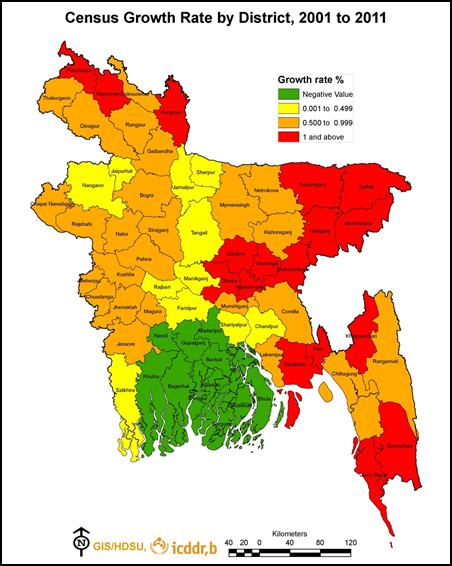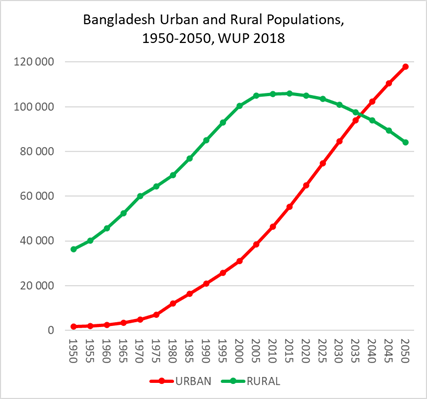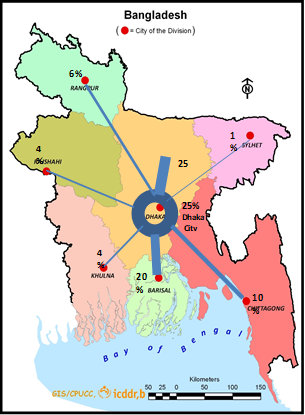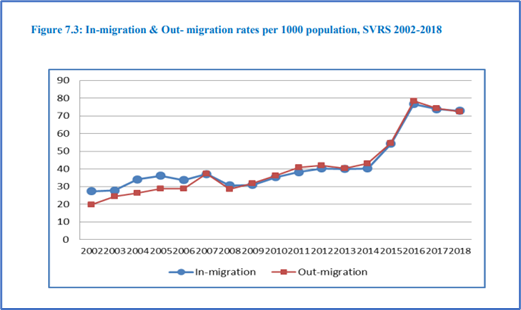One consequence of the reduced productivity of staple crops from agricultural land in these increasingly saline coastal areas is loss of traditional employment. Hence former farmers must look elsewhere for employment and different sources of household income.
The accompanying map (Fig 1) shows the differential in population growth in the various districts of Bangladesh between the 2001 and 2011 (latest) national population censuses. The southwest areas of Khulna and Barisal experienced zero population growth in that decade although demographic measures (birth and death rates) suggest that the these Divisions would have experienced about 125,000 natural increase annually. This must have been counterbalanced by 125,000 outmigration annually from each.

Fig 1: Census growth rate by District, 2001 to 2011
It may be noted that according to the UN World Urbanization Prospects 2018 the rural population of Bangladesh has peaked at 106 million. All future population growth will be in urban areas which will almost double from 65 million in 2020 to 118 million in 2050. Of course, this growth will be comprised of both natural increase and internal migration from rural areas, which will lose 20 million from the peak to 2050.

Fig 2. Bangladesh urban and rural populations, 1950-2050
Bangladesh has a relative sparsity of internal migration data, but these are several sources that give a picture of what is happening.

Figure-3
The accompanying graph (Fig 3) from the 2013 Urban Health Survey indicates that among female slum dwellers residing in Dhaka, some 20% migrated from Barisal Division. This is an overrepresentation, as Barisal accounts for only 6% of the national population.

Figure 4 The Bangladesh Bureau of Statistics (BBS)
conducts a national annual Sample Vital Registration Survey which gathers migration data but it is not easy to convert this into a clear picture of how many people are moving at any time, nor the reasons they are moving. For example, the published data show migration rates in and out of individual Divisions, but not movements within Divisions, from rural to urban, or rural to rural, which accounts for a considerable proportion of total movement.
The annual SVRS data suggest that migration has doubled between 2014 and 2016, which is surprising. The net migration rates are also quite minimal by Division
Groundswell: The recent World Bank report Groundswell: Preparing for Internal Climate Migration (2018) estimates that, by 2050, without effective climate and development interventions, around 143 million people could be forced to move within their own country due to impacts of climate change. In South Asia, that could amount to 40 million, representing 1.8 percent of the region’s total population. The report estimates that numbers of climate migrants will increase six-fold between 2020 and 2050. They will be forced to move from “less viable areas with lower water availability and crop productivity and from areas affected by rising sea level and storm surges” (Policy Note, p.1).
This prospect highlights the importance of setting up systems to monitor this large-scale migration. Existing systems are not adequate nor timely enough to reveal the changes happening in a vulnerable country like Bangladesh.
This website was produced with the support of the United States Agency for International Development (USAID) under the terms of USAID's Research for Decision Makers (RDM) Activity cooperative agreement no. AID-388-A-17-00006
Views expressed herein do not necessarily reflect the views of the U.S. Government or USAID. icddr,b is also grateful to the Governments of Bangladesh, Canada, Sweden and the UK for providing unrestricted/institutional support
68, Shaheed Tajuddin Ahmed Sarani Mohakhali, Dhaka 1212, Bangladesh
icddr,b is located at the Mohakhali area in Dhaka, just ask your driver for the "Cholera Hospital"
